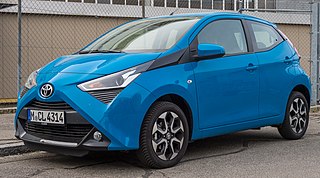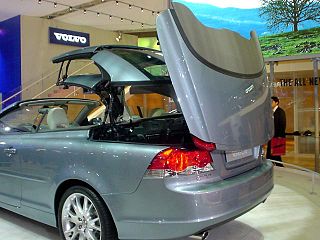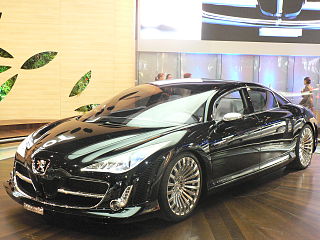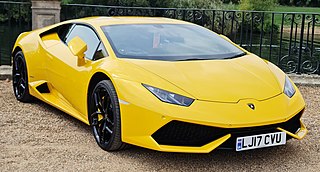
Peugeot is a French brand of automobiles owned by Stellantis.

The Supercars Championship currently known as the Repco Supercars Championship under sponsorship, is a touring car racing category in Australia and New Zealand, running as an International Series under Fédération Internationale de l'Automobile (FIA) regulations, governing the sport.

The Ford RS200 is a mid-engined, all-wheel-drive sports car that was produced by Ford Motorsport in Boreham, UK, from 1984 to 1986. The road-going RS200 was the basis for Ford's Group B rally car and was designed to comply with FIA homologation regulations, which required 200 parts kits to be produced and at least one road-legal car to be assembled. It was first displayed to the public at the Belfast Motor Show.

The Honda NSX, marketed in North America as the Acura NSX, is a two-seater, rear mid-engined, rear-wheel drive sports car manufactured by Honda.

The Peugeot 907 was a concept car built by Peugeot. Unveiled at the 2004 Paris Motor Show, the car was created by styling chief Gérard Welter and designer Jean Christophe Bolle Reddat to celebrate the closure of the firm’s 40-year-old design centre at La Garenne and the opening of the new centre at Vélizy.

The 24 Hours of Le Mans is an endurance-focused sports car race held annually near the town of Le Mans, France. It is widely considered to be one of the world's most prestigious races, and is one of the races—along with the Monaco Grand Prix and Indianapolis 500—that form the Triple Crown of Motorsport, and is also one of the races alongside the 24 Hours of Daytona and 12 Hours of Sebring that make up the informal Triple Crown of endurance racing. Run since 1923, it is the oldest active endurance racing event in the world.

The Toyota Aygo is a city car (A-segment) marketed by Toyota mainly in the European market between 2005 and 2022 across two generations. The Aygo was first displayed at the 2005 Geneva International Motor Show. It was built alongside the related Citroën C1 and Peugeot 107/108 at the Toyota Peugeot Citroën Automobile Czech (TPCA) joint venture in Kolín, Czech Republic. The Aygo's production ended in 2021 and the model was replaced by the crossover-styled Aygo X.

A retractable hardtop — also known as "coupé convertible" or "coupé cabriolet" — is a car with an automatically operated, self-storing hardtop, as opposed to the folding textile-based roof used by traditional convertible cars.

The Peugeot 308 is a small family car produced by French automobile manufacturer Peugeot. It was unveiled in June 2007, and launched in September 2007. The 308 replaced the 307, and positioned below the 508 and above the smallest 208.

The Peugeot 908 HDi FAP is a sports prototype racing car built by the French automobile manufacturer Peugeot to compete in the 24 Hours of Le Mans endurance race, starting in 2007 and eventually winning in 2009. This effort, in development since 2005, was publicly unveiled on 15 June 2006. It first competed against the Audi R10 TDI, becoming the second diesel engined sports car from a major manufacturer, and then against the Audi R15 TDI. This was Peugeot Sport's first Le Mans effort since the end of the Peugeot 905 project in 1993. It won 19 from the 28 races in which it raced between 2007 and 2011.

The Peugeot 908 RC was a concept car that was produced by the French car manufacturer Peugeot, and was first shown to the public at the 2006 Paris Motor Show. The first official pictures of the 908 RC were released in August 2006.
The Vision Gran Turismo program is a series of concept cars for the Gran Turismo video game series, developed by a cross-section of the world's top automobile manufacturers. These cars appeared originally in the video game Gran Turismo 6, and later made an appearance in each subsequent Gran Turismo installment, all developed by Polyphony Digital. For the most part, they apply present-day technology and materials, with a handful of notable exceptions that utilize novel propulsion and aerodynamic technologies. Their appearance as free update content has been staggered since the launch of GT6 in 2013, with each one being available for download upon release.

The Peugeot 508 is a mid-size/large family car produced by the French automaker Peugeot, and followed by the 508 SW, an estate version, in 2011.

The Peugeot 3008 is a compact crossover SUV manufactured and marketed by Peugeot. It was first presented to the public in Dubrovnik, Croatia in 2008, and then again in 2010 at the Mondial de l'Automobile in Paris, by the French manufacturer Peugeot. It was launched in April 2009 as the successor to the Peugeot 4007 and Peugeot 4008, and it fills a gap in Peugeot's model lineup between the Peugeot 308, with which it shares its platform, and the Peugeot 5008, its larger counterpart. The second-generation model, which is based on an EMP2 platform first seen on the second-generation Peugeot 308, was launched in 2016, with the vehicle being available as of January 2017. As of its first generation, the Peugeot 3008 was developed with the Peugeot 5008, and as of February 2019, the 3008 was developed together with the Citroën C5 Aircross, DS 7 Crossback and the Opel Grandland, sharing platforms and engines.

The DS 5 is a compact executive hatchback which was designed and developed by the French automaker Citroën, and launched in the market in Europe in November 2011. It was the third model in the premium sub brand DS. Released as the Citroën DS5, the car was relaunched as the DS 5 in 2015, following Citroën's decision to rebadge its DS models and market them under the brand DS.
Briggs Automotive Company (BAC) is a British car manufacturer that created Mono, a road-legal sports car with only one seat. BAC is based in the city of Liverpool, United Kingdom, Mono cars are exported to 47 countries around the world.

The Lamborghini Huracán is a sports car manufactured by Italian automotive manufacturer Lamborghini replacing the previous V10 offering, the Gallardo. The Huracán was revealed online in December 2013, making its worldwide debut at the 2014 Geneva Auto Show, and was released in the market in the second quarter of 2014.

The Peugeot Onyx is a concept sports car produced by the French car manufacturer Peugeot and presented at the 2012 Paris Motor Show.

The McLaren 720S is a sports car designed and manufactured by British automobile manufacturer McLaren Automotive. It is the second all-new car in the McLaren Super Series, replacing the 650S beginning in May 2017.

The Alfa Romeo Scarabeo is a concept car engineered by Giuseppe Busso and Orazio Satta Puliga for Alfa Romeo with a body designed by Sergio Sartorelli at Officine Stampaggi Industriali. The car debuted at the Paris Motor Show in 1966.



















